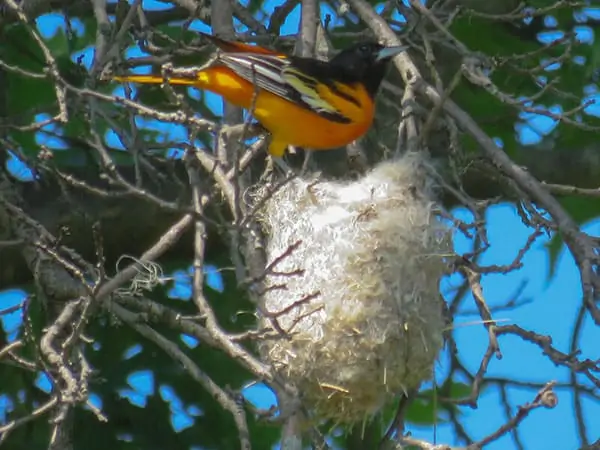Birds are precious, and they must be protected. Birds use their nests to shelter their eggs and raise their offspring, as well as protect them. Not only do they have to protect their kids from predators, but also harsh weather conditions. What do birds use to construct their nests in order to ensure their dwellings are safe? Bird species build their nests in a variety of ways, using a variety of materials. Read on to learn more about the different materials used by different species, as well as what not to include for birds.
WHAT DO BIRDS USE TO BUILD THEIR NESTS?
Birds use a variety of materials to construct their nests. Cup-shaped domes, floating nests, pendulums, and basket-shaped nests are among the options for nests. Some species, from the bottom up to the sides, employ various materials for different nest layers. The following are the most frequent materials used by birds to construct nests:
- Sticks and twigs
- Dead leaves
- Bark strips
- Feathers
- Dry grass
- Plant fluff
- Pine needles
- Bark strips
- Mud
- Moss
- Straw
Snakeskin is sometimes used for nests by certain birds, such as the big crested flycatcher (Myiarchus crinitus). To discourage squirrels from entering the nests, they will weave it into the sides and leave a portion in the nest. Spider silk is used by small birds, such as hummingbirds (Trochilidae), because it is stretchy, sticky, and hard.
WHAT BIRDS USE TWIGS FOR NESTS?
To construct a nest and layer additional layers of material, most birds will use twigs. House wrens, for example, use twigs as a bed foundation and as a barrier between tree cavity entrances and their nest; they also use twigs to protect themselves from predators. To construct the cup-like nest they build into the twig layer’s depression, they’ll utilize softer materials like grass and feathers.

The cup of the nests of Cardinals (Cardinalis cardinalis) is also shaped by twigs. Twigs, a leafy mat, grapevine bark, and a final layer of stems, grasses, and pine needles make up the four layers of their cup.
WHAT BIRD USES MOSS FOR NESTS?
Chickadees (Paridae) nest cups are built on a foundation of moss, which they use to build the cup shape. They’ll then stuff the cup with rabbit fur, which is a soft material. The outside of their cup-shaped nests are lined with moss by cedar waxwings (Bombycilla cedrorum).
WHAT BIRD USES BARK STRIPS FOR NESTS?
Robins (Turdus migratorius) and red-eyed vireo (Vireo olivaceus) are two bird species that build nests using bark strips. The exterior of robins’ cup-like nests is covered with bark, twigs, and leaves, while the inside is built on mud. Hanging cups are constructed of a framework of birch bark and wasp paper by red-eyed vireos.
WHAT BIRD USES MUD FOR NESTS?
Barn swallows (Hirundo rustica), cliff swallows (Petrochelidon pyrrhonota), and phoebes (Sayornis phoebe) are other birds that build their nests on mud like robins.
WHAT BIRD USES ARTIFICIAL FIBERS FOR NESTS?

The Baltimore orioles (Icterus galbula) use socks-like hanging nests. Artificial fibers, as well as slender fibers, are woven together. Grapevine bark strips, wool, horsehair, twine, fishing lines, and cellophane are some of the materials used. She starts by weaving the outside of the nest, then the inner of the nest, and finally she will add soft lining to cushion the eggs.
WHERE DO YOU HANG NESTING MATERIALS?
There are several ways to accomplish leaving out nesting materials for birds. By watering a mound of loose dirt, you may manufacture mud pools for birds. You can do the following for other materials:
- Pile them on the ground
- Put them in mesh bags hung on fence posts or tree trunks
- Drape them over vegetation
- Place them in open-top berry baskets
- Push them in tree crevices
SHOULD YOU PUT NESTING MATERIAL IN A BIRDHOUSE?
Don’t do it. Because you don’t know which kind of bird will be constructing a nest, it’s preferable to keep the birdhouse free of nesting materials. If the birds have to remove the materials they don’t want from the birdhouse, you’ll be giving them more work since each species uses distinct materials.
WHAT MATERIALS ARE BAD FOR BIRD NESTS?
While some things may seem like they could be useful for a bird to use to build their nest, they aren’t for most species. You want to avoid putting out:
- Tinsel
- Plastic stips
- Aluminum foil
- Cellophane
- Dryer lint
Dryer lint may seem like a good nesting material, but it absorbs water and may include harmful chemicals, such as any left softener or detergents. Dog or sheep fur, on the other hand, may be put out. Animal materials are tough and don’t hold water as much as plant materials.
IS COTTON SAFE FOR BIRDS?
That isn’t entirely accurate. Cotton, in particular, should be avoided as a nesting material for birds. Synthetic cotton is often used to make cotton, and it may include harmful chemicals for birds. Natural fibers such as raw cotton, wool, or hemp may be used instead of synthetic fibers. Since string or twine can tangle and harm the birds, make sure the lengths aren’t excessively long. 1-inch wide pieces that are less than 6 inches long are the most effective.
CONCLUSION
The materials used in the construction of birds’ nests varies. Snakeskin or spider silk is sometimes used. Dead leaves, grass, twigs, plant fluff, and straw are the most common materials used. Make certain that the nesting materials you provide birds are safe and appropriate, such as natural materials without poisons.
